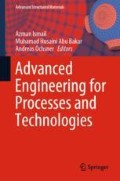Abstract
During machining processes heat is generated. The use of a cutting fluid provides lubrication and cooling effects which improve the final quality of the workpiece. Nevertheless, cutting fluid application provides some problems involving costs, environmental and health issues. In this paper, the relationship between the cutting lubricant and the surface roughness of 4340 alloy steel using three different lubricant conditions; i.e. dry machining, minimum quantity lubrication (MQL) and wet machining, is investigated. The turning parameters include the cutting speed, feed rate, cutting depth and time were considered using a carbide insert (CNMG 12 04 08-QM) H13A for light and medium turning. Then, the effects of these parameters on the surface roughness were studied. The results shows that the surface roughness is the best when using MQL on the light turning followed by wet and dry machining. Meanwhile for medium turning, the preferred condition is wet machining compared to MQL and dry machining.
Access this chapter
Tax calculation will be finalised at checkout
Purchases are for personal use only
References
Serope, K., Steven, R.S.: Manufacturing Engineering and Technology, 6th edn. Prentice Hall (2010)
Steve, F.K., Arthur, R.G., Peter, S.: Technology of Machine Tools, 6th edn. McGraw-Hill Higher Education (2005)
Geoffrey, B., Winston, A.K.: Fundamentals of Machining and Machine Tools, 3rd edn. CRC Press, Taylor & Francis Group (2006)
Hassan, E.H.: Fundamentals of Machining Process—Conventional and Nonconventional Processes. CRC Press, Taylor & Francis Group (2007)
Acknowledgements
We would like to thanks UniKL MSI for the financial support for the research.
Author information
Authors and Affiliations
Corresponding author
Editor information
Editors and Affiliations
Rights and permissions
Copyright information
© 2019 Springer Nature Switzerland AG
About this chapter
Cite this chapter
Zubir, B., Abdul Razak, M.Z., Abd Rahman, A.F., Said, M.S. (2019). The Effect of Cutting Fluid Condition on Surface Roughness in Turning of Alloy Steel. In: Ismail, A., Abu Bakar, M., Öchsner, A. (eds) Advanced Engineering for Processes and Technologies. Advanced Structured Materials, vol 102. Springer, Cham. https://doi.org/10.1007/978-3-030-05621-6_27
Download citation
DOI: https://doi.org/10.1007/978-3-030-05621-6_27
Published:
Publisher Name: Springer, Cham
Print ISBN: 978-3-030-05620-9
Online ISBN: 978-3-030-05621-6
eBook Packages: EngineeringEngineering (R0)

